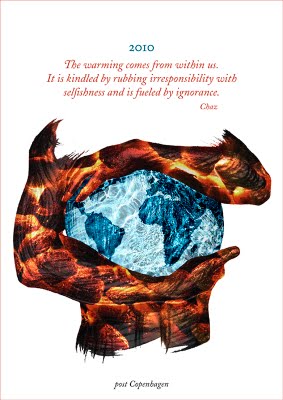Friday, January 01, 2010
Wednesday, December 30, 2009
Maria Magdalena Campos-Pons
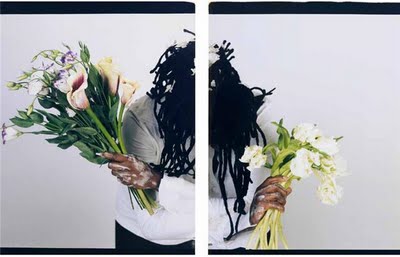
Maria Magdalena Campos-Pons continues to explore her own identity while also engaging with current American politics in her exhibit “Hope: Yes We Can” at Bernice Steinbaum Gallery in Miami. The Cuban-born, Brookline, Massachusetts-based artist’s recent Polaroids stand at the crossroads of photography and performance and painting. They seem to document rituals of celebration, self-discovery, mourning.
“Prayer for Obama II," 2008, (pictured at top) shows Campos-Pons holding flowers and bowing. It was photographed on the morning of Nov. 4, 2008, the day Barack Obama was elected president. (Campos-Pons hosted an election results watching party at her GASP Gallery in Brookline that night.) The gallery notes a detail: “A tiny finger-puppet of Obama, given to her as a good luck gesture by a friend, is cradled in the palms of her hands and wrapped in purifying garlic, playfully anchoring the seven images.” In contrast, “Mourning Bouquet” (2008) uses exotic, midnight-blooming flowers to memorialize the death of soldiers in Iraq.
“My Mother Told Me I Am Chinese: Painting Lesson” (2008) speaks, the gallery says, of Campos-Pons’s “Chinese ancestry from her mother’s grandmother who came to Cuba with other Chinese contract workers in the mid 1800’s and worked in the tobacco and sugar cane fields alongside Africans, many of whom were still enslaved. … The white make-up on Campos-Pons’s face in this work alludes to the costume worn in traditional Chinese style theater, but rather than imitating the idealized porcelain doll appearance, the artist applies the paint in broad strokes that dries unevenly, implying both an inexactness to her own heritage as well as making reference to the paint called cascarilla that was used in the ceremonies and initiations of Santeria.”
Previously:
Our 2009 interview with Maria Magdalena Campos-Pons.
Our 2007 profile of Campos-Pons.
Maria Magdalena Campos-Pons, “Hope: Yes We Can,” Bernice Steinbaum Gallery, 3550 N. Miami Ave., Miami, Florida, Nov. 14, 2009, to Jan. 2, 2010.
Pictured from top to bottom: Maria Magdalena Campos-Pons “Prayer for Obama II,” 2008, Polaroid prints, 29 ¼ x 46 ½ inches; “Mourning Bouquet,” 2008, Polaroid prints, 56 x 49 inches; and “My Mother Told Me I Am Chinese: Painting Lesson,” 2008, Polaroid prints, 84 ¼ x 171 5/8 inches (21 panels).
Tuesday, December 29, 2009
Walton Ford
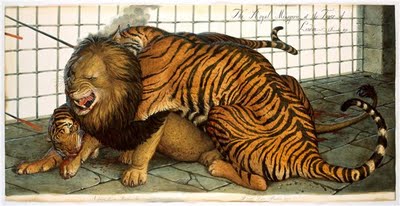
Walton Ford of Great Barrington, Massachusetts, is undoubtedly one of the most extraordinary artists active in New England. He paints monumental watercolors that speak of the meeting of people and animals and how this interaction sets off chain-reactions of disaster. The vividly realistic paintings, with traces of faux aging, resemble 19th century natural history specimen sketches – particularly the work of John James Audubon – but they overturn that era’s sense of the superiority of man to animals, to nature. Ford’s version, as evidenced in his just closed show at Paul Kasmin Gallery in New York, is haunted by today’s looming ecological disasters. The animals are beyond human control. A comeuppance is coming.
However Ford’s historical references can be obscure, which can cloud what the paintings are about. His 2009 painting “The Royal Menagerie at the Tower of London- 3 December 1830” (pictured above) depicts a bloody tussle between two tigers and a lion in some sort of enclosure. Three lines approach the big cats from the left, and approach a cloud of smoke near where one tiger seems to be biting the lion. Some of what’s happening becomes clear when you read the gallery’s description of the painting. It depicts “a historical incident at the royal menagerie at the Tower of London in 1830, two Bengal tigers ensnare a snarling lion as unseen guards attempt to control and separate them with red-hot steel rods.” The scene seems to draw on the specific event to make a point about our inability to control nature. The specificity seems important, but it’s not clear from the painting why this specific incident is recalled.
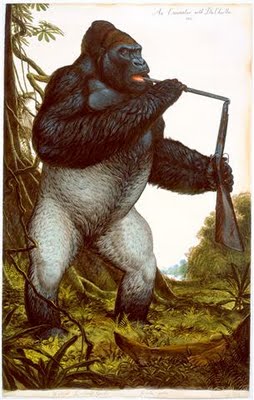 “An Encounter with Du Chaillu” (pictured at left) seems to reference the 19th century anthropologist Paul du Chaillu who claimed to be the first white guy to see the gorillas of central Africa and return to tell the story. And he loved to tell – and apparently embellish – the story. At a New York church in 1875, he spoke of adventures among African cannibals and hunting gorillas. “On the third day he came in sight of a huge warrior gorilla, who was gnashing his teeth in rage as he was endeavoring to tear down a tree covered with berries,” The New York Times reported of Du Chaillu’s speech. “The creature advanced toward him with fierce yells, beating his huge breast with his fists until it sounded like a drum, and evidently was not in the least afraid of the four men. Du Chaillu did not fire until the gorilla was within twelve feet of him, and then he shot him through the heart, so that the creature fell dead before him on its face with a human-like groan.”
“An Encounter with Du Chaillu” (pictured at left) seems to reference the 19th century anthropologist Paul du Chaillu who claimed to be the first white guy to see the gorillas of central Africa and return to tell the story. And he loved to tell – and apparently embellish – the story. At a New York church in 1875, he spoke of adventures among African cannibals and hunting gorillas. “On the third day he came in sight of a huge warrior gorilla, who was gnashing his teeth in rage as he was endeavoring to tear down a tree covered with berries,” The New York Times reported of Du Chaillu’s speech. “The creature advanced toward him with fierce yells, beating his huge breast with his fists until it sounded like a drum, and evidently was not in the least afraid of the four men. Du Chaillu did not fire until the gorilla was within twelve feet of him, and then he shot him through the heart, so that the creature fell dead before him on its face with a human-like groan.”De Chaillu told many tales, so I’m not sure what story Ford may be referencing, or how much he might be embellishing himself. In Ford’s painting, a gorilla stands on its two legs and presses the end of a rifle barrel against his tongue as if tasting it. The gun is bent and the butt is bloody. Then you notice that among the ferns at the ape’s feet, lay the battered legs of a person. It’s not clear just what has happened, but the title suggests that this time the gorilla won.
Previously:
Our review of "Tigers of Wrath," Walton Ford's 2006 retrospective at the Brooklyn Museum of Art.
Walton Ford “New Work,” Paul Kasmin Gallery, 293 10th Ave., New York, Nov. 12 to Dec. 23, 2009.
Pictured from top to bottom: Walton Ford, “The Royal Menagerie at the Tower of London-3 December 1830,” 2009, watercolor, gouache, pencil, and ink on paper, 60 x 119 1/2 inches, and “An Encounter with Du Chaillu,” 2009, watercolor, gouache, pencil, and ink on paper, 95 1/2 x 60 inches. Images are courtesy of Mr. Ford and Paul Kasmin Gallery.
Monday, December 28, 2009
Art Awards nominations so far
Below are some nominations that we've received so far for the 2009 New England Art Awards, which is a contest to honor the best art made here and exhibits organizes here this year. And we're seeking nominations through 11:59 p.m. Sunday, Jan. 3. Anyone can make nominations here. So if you don't see a show or artist you like in the list below, now is the time to make your voice heard.
Some nominations for the 2009 New England ARt Awards:
Harry Callahan at the MFA
June August
jesse kaminsky
Coil/Recoil by Lisa Greenfield
Starry Night - Lisa Greenfield and Daniel J. van Ackere
Ryan Trecartin and Lizzie Fitch at the Rose Museum, Waltham
Fischli & Weiss the Way Things Go List Center
Zsuzsanna Szegedi
Halloween Iron Pour at the Steel Yard
The Steel Yard Iron Chef Competition
Honk Parade
Joanne Rice
Marta Renzi
Perestroika; 3rd Anniversary Show, Jacques Cabaret, Boston
John O'Reilly
Joe Deal New Work / RISD Museum
Steel Yard Public Projects
Joseph Wheelwright
Anna Hepler: intricate Universe
Ria Brodell: Out of the Forest
Hirokazu Fukawa at Real Art Ways, Hartford
Pelle Cass in New England Photography Biennial, Danforth Museum
Megapolis Audio Festival - Justin Grotelueschen, Nick van der Kolk
ACT UP at Harvard
Fixed Chaos at Montserrat
Rockstone and Bootheel; Real Art Ways; curated by Kristina Newman-Scott and Yona
add and subtract (bkprojects @ kayafas)
Salt of the Earth at Montserrat
Albrecht Durer at MFA
Melody and Witness at GASP
Beyond the Literal at GASP
Gerry Berenstein at Gallery Naga
Peter Schumann exhibit at BCA and Vermont
Amy Stacey Curtis: Sort at Montserrat
Daniel Phillips: tear Down these Walls at Montserrat
“Made in Fort Point” shop at Fort Point Artist Community
Jenny Holzer at Montserrat
Bread and Puppet performances in Vermont and at BCA
"Heroes Stories" By Cullen Washington at The National Museum of African American Artist
Some nominations for the 2009 New England ARt Awards:
Harry Callahan at the MFA
June August
jesse kaminsky
Coil/Recoil by Lisa Greenfield
Starry Night - Lisa Greenfield and Daniel J. van Ackere
Ryan Trecartin and Lizzie Fitch at the Rose Museum, Waltham
Fischli & Weiss the Way Things Go List Center
Zsuzsanna Szegedi
Halloween Iron Pour at the Steel Yard
The Steel Yard Iron Chef Competition
Honk Parade
Joanne Rice
Marta Renzi
Perestroika; 3rd Anniversary Show, Jacques Cabaret, Boston
John O'Reilly
Joe Deal New Work / RISD Museum
Steel Yard Public Projects
Joseph Wheelwright
Anna Hepler: intricate Universe
Ria Brodell: Out of the Forest
Hirokazu Fukawa at Real Art Ways, Hartford
Pelle Cass in New England Photography Biennial, Danforth Museum
Megapolis Audio Festival - Justin Grotelueschen, Nick van der Kolk
ACT UP at Harvard
Fixed Chaos at Montserrat
Rockstone and Bootheel; Real Art Ways; curated by Kristina Newman-Scott and Yona
add and subtract (bkprojects @ kayafas)
Salt of the Earth at Montserrat
Albrecht Durer at MFA
Melody and Witness at GASP
Beyond the Literal at GASP
Gerry Berenstein at Gallery Naga
Peter Schumann exhibit at BCA and Vermont
Amy Stacey Curtis: Sort at Montserrat
Daniel Phillips: tear Down these Walls at Montserrat
“Made in Fort Point” shop at Fort Point Artist Community
Jenny Holzer at Montserrat
Bread and Puppet performances in Vermont and at BCA
"Heroes Stories" By Cullen Washington at The National Museum of African American Artist
Yokelist Manifesto 6: Could the CIA help?

It's not much talked about in the art world, but from the 1930s to the ‘60s, the CIA, U.S. State Department, and U.S. Information Agency – with help from New York’s Museum of Modern Art and major American corporations – organized exhibitions of avant-garde American art in Europe and Latin America to exemplify the benefits of American-style democracy, capitalism and freedom. These cultural diplomacy programs were a sort of classy American propaganda, aimed at countering the spread of communist Soviet influence during the Cold War. But they were also key in showing, as MoMA leaders said, “that America was not the cultural backwater,” in promoting New York artists, and in establishing that city as the post-war world capital of art.
Maybe we need the CIA’s help in promoting the best of New England art today.
The art world tells a fairy tale that the best art prevails on its own because the art world is some sort of meritocracy. And, by corollary, New England art doesn’t prevail because it is provincial junk. But that’s not true. Most artists that rise to the top – institutionally, economically – do so because they’ve gotten the support of a huge infrastructure that incubates and champions their work – and then aims to profit off it.
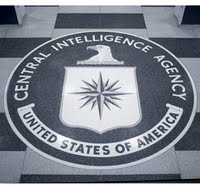 New York didn’t just become the capital of art at midcentury because it had good artists. It claimed that spot because it had the backing of major institutions, including, amazingly enough, the CIA, that made it their mission to promote New York art to the world. It helped that the art was good. And it helped that the former capitals of Western art – Paris and Berlin – were shattered by a world war. But the promotional infrastructure played a key part – and still plays a major part.
New York didn’t just become the capital of art at midcentury because it had good artists. It claimed that spot because it had the backing of major institutions, including, amazingly enough, the CIA, that made it their mission to promote New York art to the world. It helped that the art was good. And it helped that the former capitals of Western art – Paris and Berlin – were shattered by a world war. But the promotional infrastructure played a key part – and still plays a major part.I expect the CIA won’t come to New England’s aid. So we’ll have to do this ourselves. Our local institutions – our museums, schools, news media – need to engage more with art made here. And shows of local art organized here need to tour to museums outside the region. Looking to the example of those midcentury cultural diplomacy exhibitions, I propose a New England exhibition exchange program. For example, DeCordova Sculpture Park + Museum in Lincoln, Boston’s Institute of Contemporary Art and the Portland Museum of Art organize annuals and biennials championing exciting art made in New England, but how many people outside the region see them? How many people outside of the towns they’re in see them? I propose that these shows be swapped across New England, and then also swapped with regional art roundups from, say, Seattle, Los Angeles, San Francisco, Houston, Chicago, Philadelphia. If you need a model, look at a similar program that local curators already often tap when looking for artists to fill our museums – it’s the New York-centered Circuit of art biennials, art fairs, art auctions and New York museums and galleries.
Over and over you hear it said that we live in a global art world, but so much of art world success still depends on where you live, on your geographic proximity to that art world infrastructure. A third of the artists featured in Phaidon’s major new art world survey book “Painting Today” reside in New York. Not just show in New York – reside in New York. If that’s not successful provincialism, what is?
If the main mode for art world success remains living in New York, we might as well all give up here. But the decentralized nature of the Internet offers a new model for how the art world can work. We can become art localvores. We can build institutions that incubate and champion art made here. We can found our own circuit with other local yokels in supposed cultural backwaters off the Circuit’s beaten path.
Some will talk of the dangers of provincialism, but look at how well provincialism did for New York, which is an example of how to be provincial while still maintaining high aesthetic standards. If we don’t risk the pitfalls of being proudly provincial – let’s call it Yokelism – then we’re just supporting a status quo that says we don’t, won’t ever matter.
Previously
Yokelist Manifesto Number 1: Boston lacks alternative spaces?
Yokelism at the 2008 Boston Art Awards.
Yokelist Manifesto Number 2: Montreal case study.
Yokelist Manifesto Number 3: Hire locally.
Yokelist Manifesto Number 4: We need coverage of our living artists.
Yokelist Manifesto Number 5: We need local retrospectives.
Yokelism update: Coverage of our living artists: Sebastian Smee responds.
Pictured at top: The CIA's Intelligence Art Gallery, for real.





